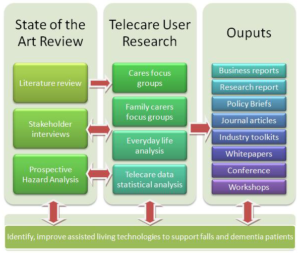ACTIVE project
This is a short overview of the AKTIVE project research and development activities.

Overview
State of the art review
The main objective of the state of the art review of literature and evidence is to create a comprehensive summary of current knowledge baseline data to inform all other project activities and outputs. Based on this review, outputs for dissemination to stakeholders in industry, voluntary sector and academia will be produced.
The state of the art review will be complemented with expert interviews with 24 stakeholders to explore and take into account policy, delivery and market context.
Telecare user analysis
The analysis of telecare users will be conducted through a combination of focus groups with care workers and family carers, secondary analysis of telecare monitoring data and everyday life analysis of telecare use.
Data will be obtained from 30-40 professional care workers about their views/experiences of using telecare in delivering homecare support to clients with memory problems/falls diagnoses. The views and experiences of family care-givers of older telecare users with memory problems/falls diagnoses will be collected to explore any difference in uses/experiences between these groups.
The descriptive and multivariate analysis of telecare monitoring data from Leeds and Oxfordshire will be the basis of a report. An Everyday Life Analysis will be conducted to gain deep, contextualised understanding of how telecare is used and its impact upon the everyday lives of older people living at home with memory problems/susceptible to falls and any/all members of their caring network, in consultation with a wide range of relevant experts.
Falls and memory problems telecare product development
This will consist in developing new and improving existing telecare solutions for both falls and memory problems patients for piloting and testing throughout the project. Existing telecare solutions for both falls and memory problems’ patients will be improved and new ones developed to enable piloting and testing throughout the project. Prospective Hazard Analysis (PHA), which is a tool to address potential risks will be used to explore those that may arise from assisted living technologies use and suggest potential improvements and innovations. PHA can also be used to examine why a particular product or intervention does not work in the way it was designed to and therefore has the potential to allow us to address why particular ALTs are not successfully adopted and used by F&D; patients and their carers.
Dissemination of research outputs
The objective is to ensure that state of the art, all new evidence, developments and analysis arising from the project, and good practice example identified in all relevant areas of practice (marketing, commissioning, social care organisation, training and management, carer support and training, user support and guidance, hazard avoidance, etc.) are disseminated.



